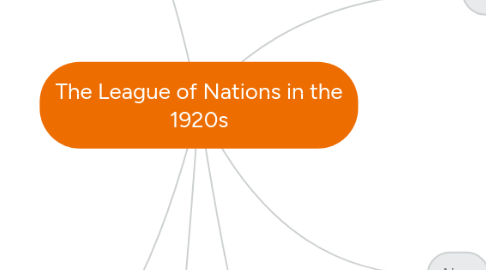
1. Membership
1.1. Aim: To have a broad membership
1.1.1. Strength Quantity of Membership
1.1.1.1. Volume: 42 < 65
1.1.2. Weakness: Quality of Membership
1.1.2.1. Germany and USSR: Not allowed to join
1.1.2.2. France and Britain: To weak to lead
1.1.2.3. USA: Refused to join
2. Borders
2.1. Aim: To settle disputes peacefully
2.1.1. Failures
2.1.1.1. Vilna (1920): Poland seized Vilna from Lithuania. The League chose not to react because Poland was an ally against Germany and the USSR. This was considered cynical.
2.1.1.2. Corfu (1923): The League decide not to act against the Italians, instead, it blames the Greeks for failing to protect the Conference of Ambassadors, and orders them to pay compensation to the League. This suggests that the League was not prepared to stand up for the right of smaller nations.
2.1.1.3. Bulgaria (1925): The League decided to act against the Greeks, who were ordered to withdraw from Bulgaria and also to pay a massive sum of compensation to the Bulgarians. This proves that the League was more interested in looking after powerful nations than in promoting justice.
2.1.2. Successes
2.1.2.1. Aaland Islands (1921): Sweden and Finland argued over ownership of the Aaland Islands. The League awarded the islands to Finland on the condition they remained demilitarised. Sweden accepted this decision.
2.1.2.2. Upper Silesia (1921): The treaty of Versailles arranged for a plebiscite, but despite the fact that Germany won, Poland refused to accept the decision, and riots started to break out. A plebiscite was later organised, and Upper Silesia was peacefully divided between the two countries.
2.1.2.3. Teschen (1919): The League gave the bulk town to Poland, but the slice given to Czechoslovakia cointained most of the coal mines, and fortunatly, no more violence occured.
3. Disarmament
3.1. Aim: To promote world disarmament
3.1.1. Why were countries unwilling to disarm
3.1.1.1. Britain
3.1.1.1.1. Washington Agreement: Britain had a private naval deal with the USA and Japan (1921)
3.1.1.2. France
3.1.1.2.1. Maginot Line: France invaded the Ruhr region of Germany to extract reparations in 1923, and started building fortifications along her German Border
3.1.1.3. Germany and USSR
3.1.1.3.1. Rapallo Treaty: Germany was receiving military supplies from the USSR (1922)
3.1.2. Successes
3.1.2.1. Germany disarmed: 100 000 men
3.1.3. Failures
3.1.3.1. Kellogg-Briand Pact: 65 nations signed the “Kellogg-Briand Pact” (1928) in which they promised to renounce war “as an instrument of national policy”: except there was no way of enforcing their promise.
3.1.3.2. France: Didn't trust Germany
3.1.3.3. Britain: was arogant - they thought that they were the ultimate intrument of peace and argued that it couldn't disarm as it needed to protect its vast empire.
4. Aims
4.1. Political: Discourage aggression through collective security
4.2. Military: Encourage world disarmament
4.3. Social: Improve living and working conditions
4.4. Economic: Get countries to co-operate rather than compete in business and trade
5. Structure
5.1. Aim: To be efficient and effiective
5.1.1. Failures
5.1.1.1. No Army
5.1.1.2. Unanimous Voting
5.1.1.3. Quality of Membership
5.1.2. Successes
5.1.2.1. Adminstration
5.1.2.1.1. Assembly
5.1.2.1.2. Council
5.1.2.1.3. International Court Of Justice
5.1.2.2. Actions: Flexible and scale upwards
5.1.2.2.1. Moral Condemnation: An official, public critism of the agressor by the League
5.1.2.2.2. Economic Sactions: League members refuse to trade with the agressor
5.1.2.2.3. Military Force: The League uses its own army to attack the aggressor
6. Social Affairs
6.1. Aim: To improve working and living conditions
6.1.1. ILO
6.1.1.1. Problem: Terrible working conditions creating social distress which could lead to communist revolutionaries getting support.
6.1.1.2. Solution: Banned lead from white paint
6.1.2. WHO (World Health Organisation)
6.1.2.1. Problem: Destruction and starvation produced a typhus epidemic killing hundreds of thousands of people.
6.1.2.2. Solution: Provided sanitation and medicine on the Russian borders to prevent the disease from spreading into Europe.
6.1.3. Refugee Org.
6.1.3.1. Problem: Almost 1.5 million Russians flee their country following the communist revolution, creating a massive refugee problem.
6.1.3.2. Solution: Repatriated 400,000 Prisoners of War
6.1.4. Slavery Org.
6.1.4.1. Problem: Slavery
6.1.4.2. Solution: Liberated 200,000 slaves in Sierra Leone
